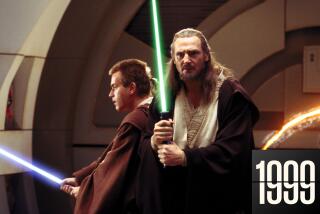‘Star Wars’ Set Has Its Dark Side
- Share via
It’s a massive, heavy package holding nine laser video discs, a 207-page full-color book and a 16-page guidebook. The 18 sides containing the best-looking video and the best-sounding audio yet created for home viewing takes most of a day to watch. It’s the “Star Wars Trilogy: The Definitive Widescreen Collector’s Edition,” one of the most extravagant releases in home video’s short history. And all it costs is $250.
Whether that hefty price tag is worth it depends on your feelings about George Lucas’ “Star Wars,” “The Empire Strikes Back” and “Return of the Jedi.” If you still get goose bumps when you think back to the 1977 premiere of the original “Star Wars,” if your closet is filled with “Star Wars” toys, T-shirts and lunch pails, then you won’t be disappointed in adding this purchase to your collection.
The three-film set from Fox Video/Image Entertainment released this week is imposing in almost every way. Even if your home set is not THX-equipped or close to that level, “Star Wars Trilogy” is one transfer to laser that will knock you into hyperspace. Almost literally, if you don’t keep your system’s sound level in check.
The trilogy is all on CAV, which means you can stroll a frame at a time through these early, landmark Industrial Light & Magic special effects. Oddly enough, most of the early effects, dazzling as they were when “Star Wars” first exploded on the scene, have been eclipsed by their successors, the computerized, digitized effects that have waged their own revolution in the last 16 years.
With the standard-play format, you can take as long as you want to review the great battle scenes in all three movies, the explosion of the Death Star, Darth Vader and Luke Skywalker’s light-saber confrontations, the Millennium Falcon streaking through asteroids, Jabba the Hutt snacking, the attack of the wampa ice creatures, Han Solo coming out of the carbon-freeze, speeder bikes whooshing through the forest. With a touch of a button, it’s all available in stop action, slow motion, fast motion, forward and backward.
The characters and actors immortalized by Lucas and the other writers and directors he brought to the project look young and fresh and vital and haven’t been seen in such beautiful clarity since “Star Wars” first entered the vocabulary: Mark Hamill as Luke Skywalker, Carrie Fisher as Princess Leia, Harrison Ford as Han Solo, Alec Guinness as Obi Wan Kanobi, Billy Dee Williams as Lando Calrissian. The majestic, frightening, importuning voice of James Earl Jones as Darth Vader booms forth grander than ever.
Previous Fox releases of the three “Star War” films have not been available with both letterboxing and standard play CAV, as this has. Watching this new edition at home is as close as you will get to the big-screen experience. The sound is better and the picture sharper, albeit smaller.
That experience for those who saw “Star Wars” in the theater, however, varied greatly depending on where, and when you saw it. There were three different audio mixes accompanying the original “Star Wars”: a 70-millimeter, six-track mix; a 35mm Dolby stereo mix and a 35mm monaural mix. This new THX soundtrack pulls together the best elements of all three, restored with the highest of high-tech equipment, according to Fox/Image.
The next-best thing to the sound is the superlative picture: rich, detailed, crisp colors that preserve flesh tones yet sweep through the rainbow to produce dramatic, vibrant colors in the flush of battles pulled from mattes, miniatures, blue screens and a host of other effects discussed in the supplemental material.
But this special wide-screen collector’s edition harbors inside of it its own Dark Side. The supplemental materials in this otherwise stellar re-release collection is abysmal, falling embarrassingly short of what might have been. If ever a laser video project cried out for a well-delineated second audio track, with a full discussion of the individual films’ shots, themes and references, this is the one.
Instead, the producers threw the chance away. All we get is a jumble of commentaries in poor audio thrown on the discs in a haphazard way surrounded by dead air. They come and go like spaceships in the night. That is, if you can find them on the audio track. While a supplemental brochure very clearly lists chapter stops for both the film and the analog track, there are enough times that the audio track is mislabeled to make you wonder if you just can’t read or count at all. What’s advertised as being on Chapter 17 is really on Chapter 18. Another time a track listed as a Lucas discussion can’t even be found no matter how hard you try. To make matters worse, whole sides of discs have a few or even just one audio commentary. What a botch. There obviously wasn’t enough of the Force left when it came to producing the supplementary materials.
And that isn’t all. Much of the supplemental material that comes at the end of each film, especially the commentaries on “Return of the Jedi,” turn out to be no more than reiterations of statements just heard on the last audio track. It’s the final insult to have had to hunt through lasers trying to find separate pieces of audio, only to have them repeated all in one place at the end of the film. The fault lies not with the commentaries per se, since many of the creators of the film offer interesting asides, but their placement and their illogical organization.
And except for a few mundane minutes here and there where, for instance, is Lucas, the mind behind the mission? Why isn’t he narrating the complete track of each film, with sound effects, visual effects, design consultants and other major contributors brought in at key points to explain in detail what we are seeing and how it all came about? Why can’t we hear the John Williams score, which contributes so mightily to the “Star Wars” experience, under such a discussion? And where are the actors talking about their roles and how “Star Wars” changed their lives?
To be sure, there are fascinating moments from the participants--senior visual effects supervisor Dennis Muren; sound designer Ben Burtt; cameraman Ken Ralston; conceptual artist Ralph McQuarrie; puppeteer Frank Oz, and Lucas himself.
The “collector’s edition” also includes Times Arts Editor Emeritus Charles Champlin’s recently published biography of filmmaker Lucas. But while Champlin devotes at least a chapter to each film, his book was never intended to be a detailed look at the individual movies in the trilogy, but a look at the filmmaker’s career. It’s a bonus for the Lucas fan, but it shouldn’t replace providing an informative, well-designed brochure, especially when the 16-page guide to the discs includes unpardonable errors.
More to Read
The biggest entertainment stories
Get our big stories about Hollywood, film, television, music, arts, culture and more right in your inbox as soon as they publish.
You may occasionally receive promotional content from the Los Angeles Times.










